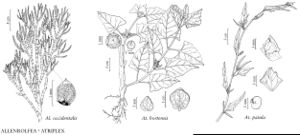Difference between revisions of "Atriplex patula"
Sp. Pl. 2: 1053. 1753.
FNA>Volume Importer |
FNA>Volume Importer |
Revision as of 22:25, 16 December 2019
Herbs, monoecious or subdioecious, (1.5–)3–9(–15) dm. Stems mostly erect and branched, branches green, obtusely angled or striate, glabrate. Leaves alternate except the proximalmost, petiolate; blade green on both sides, rhombic-lanceolate to lanceolate, oblong, or narrowly lance-oblong or hastate-ovate, 25–120 × 3–40(–75) mm, entire or toothed, proximal ones broadly cuneate or sometimes hastate subbasally with obliquely antrorse basal lobes, distal cauline leaves lanceolate and entire. Flowers compact or interrupted spiciform or paniculiform clusters. Staminate flowers mostly 5-merous. Fruiting bracteoles green becoming black, rhombic to rhombic-triangular, or ovate-rhombic, compressed, ± uniformly sized, 2–7(–20) mm, base mostly hastate, acute, margin united almost to middle, entire or sparingly toothed, surfaces tuberculate. Seeds dimorphic: brown, 2.5–3(–3.5) mm wide, or black, 1–2 mm wide; radicle of brown seeds subbasal to median, antrorse. 2n = 36.
Phenology: Flowering summer–fall.
Habitat: Widespread ruderal weed of nonsaline substrates such as fields, gardens, and roadsides
Elevation: 0-2100 m
Distribution

Alta., B.C., Man., N.B., Nfld. and Labr. (Nfld.), N.S., Ont., Que., Sask., Yukon, Ala., Alaska, Calif., Colo., Del., D.C., Idaho, Ill., Ind., Iowa, Maine, Md., Mass., Mich., Mo., Mont., Nev., N.H., N.Y., N.C., N.Dak., Ohio, Pa., R.I., S.Dak., Utah, Vt., Va., Wis., Wyo., Europe, Asia, n Africa.
Discussion
Atriplex patula appears to have been a rather recent introduction in North America from Eurasia, not arriving perhaps until sometime in the early to mid-eighteenth century. It simulates depauperate specimens of A. dioica, A. glabriuscula, and other similar species when leaves are reduced to a near-linear profile. Such specimens are difficult if not impossible to assign to any of the species.
Selected References
None.
